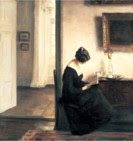
Eleanor Talbot’s name is really only known to students of the controversy over Richard III’s accession to the throne in 1483. Richard claimed the throne on the death of his brother, Edward IV, on the grounds that Edward had been married to Lady Eleanor Talbot before he contracted a clandestine, bigamous marriage with Elizabeth Woodville, the woman who had been acknowledged as his queen. This meant that their children, including the boys Edward V & Richard, Duke of York, were illegitimate & could not succeed to the throne. Eleanor had died years earlier & the only surviving witness was Robert Stillington, Bishop of Bath & Wells, who had come forward after Edward IV’s death & told Richard, then Duke of Gloucester, this stunning news.
Ever since, & especially after the disappearance of young Edward & Richard, the Princes in the Tower, debate has raged as to the truth of the story of the marriage of Eleanor & Edward. Pro-Ricardians have accepted the story as true as it justified & explained what was otherwise seen as Richard’s usurpation of the throne. Anti-Ricardians see it as a fabrication which allowed Richard to do what he was planning to do anyway. Usurp the throne & murder his nephews. I’m a member of the Richard III Society, & I’ve been reading John Ashdown-Hill’s articles on this subject for some years. Now, he has consolidated his research into this fascinating book, which seeks to illuminate the shadowy figure of Eleanor & bring together the evidence for the marriage.
Lady Eleanor Talbot was the daughter of John Talbot, first Earl of Shrewsbury, one of the great heroes of the Hundred Years War against France. To get some idea of his celebrity in the medieval world, Ashdown-Hill compares him to Churchill during WWII. Ashdown-Hill spends the first half of the book setting the scene of Eleanor’s life. He introduces us to her family & her place in the wider sphere of the nobility. Eleanor was related to the Earls of Warwick. She was the niece of the Kingmaker & first cousin to Isabel & Anne Neville who married George & Richard, brothers of Edward IV. All this genealogical detail can be confusing (especially when there are so many Johns, Edwards & Thomases) & dull but I found this part of the book fascinating. I had never before realised just how well-connected Eleanor Talbot was. She & Edward IV were related through their descent from the Mortimer family, Earls of March. If Edward had decided to acknowledge his relationship with her, she was not an unworthy match for the King of England. Certainly she was no less well-born than Elizabeth Woodville.
Ashdown-Hill is also successful in giving an idea of Eleanor’s character, mostly through her later life as a patroness of the Carmelite Friars of Norwich. It can be very difficult to describe the life of an individual medieval woman because they had so little to do with public life. Unless they were queens or religious mystics, their voices were rarely heard. Eleanor lived a quiet life with her family until her marriage at the age of 13 to Thomas Butler, son of the Earl of Sudeley. Thomas was 28 but the age difference wasn’t unusual for the period. Eleanor went to live with her husband’s family but the marriage wasn’t consummated until she came of age. Eleanor’s life with her husband was short as he died only a few years after they started living together & she was a widow at 23.
It’s not known exactly when or where Eleanor & Edward met, but their relationship followed a pattern familiar from his later relationship with Elizabeth Woodville. Eleanor was an attractive young widow, a few years older than Edward. He fell in love with her but she refused to become his mistress. They went through a form of marriage in the presence of Stillington (usually called a pre-contract but the author dismisses this as incorrect. It was a marriage). Edward moved on to another woman very quickly & Eleanor went on living with her sister Elizabeth, Duchess of Norfolk, & becoming involved as a benefactress & eventually as a tertiary member of the congregation. She was not a nun but took some vows & was buried in the priory after her death at the age of 32. Eleanor comes across as a modest, reserved, devout woman who may have been upset & dismayed by the end of her relationship with Edward but too proud to assert her rights when he subsequently married Elizabeth Woodville. Ashdown-Hill speculates that Stillington may have told George, Duke of Clarence about Edward’s marriage to Eleanor & this may have influenced his erratic behaviour which ended with him convicted of treason & being executed (traditionally drowned in a butt of malmsey). Stillington’s career is also hard to understand unless he had some knowledge that Edward wanted to suppress.
There’s so much more in this book which sheds light on the actions & motivations of many of the people involved in the events of 1483 & after. Ashdown-Hill was able to arrange the examination of a skeleton recovered from archaeological excavations of the Carmelite Priory to see if it could be Eleanor. He also looks at Eleanor’s reputation in the centuries since her death & how she has been portrayed by historians & novelists. This book, about “the woman who put Richard III on the throne” as the subtitle puts it, reclaims a forgotten but vitally important figure from medieval history.




































